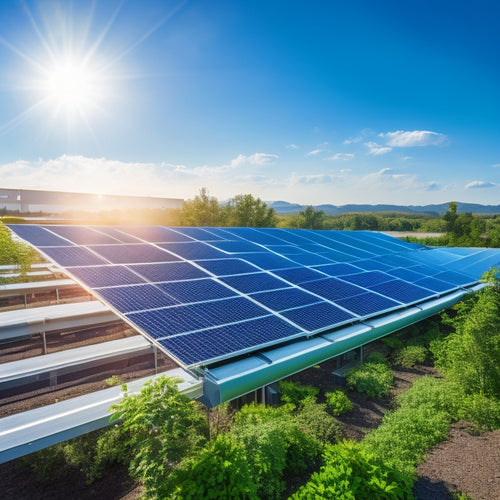
Why Use a Commercial Solar Panel Financing Calculator?
Share
Using a commercial solar panel financing calculator gives you accurate, data-driven insights into your investment. It helps estimate costs, determine ROI, and calculate the payback period. You can also compare financing options and analyze interest rates to minimize financial risks. The tool provides detailed projections of net savings, helping you plan your budget effectively. By accounting for incentives and maintenance expenses, it guarantees thorough financial clarity. Simplifying complex financial data, it supports informed decision-making with ease. Explore further to understand all the benefits this tool offers for optimizing your solar investment.
Key Takeaways
- Provides instant insights on cost savings and ROI.
- Helps determine accurate payback periods.
- Reduces financial uncertainty with precise cost estimations.
- Compares various financing options for optimal decisions.
- Simplifies budget planning with detailed expense tracking.
Accurate Cost Estimation
To precisely calculate the cost of commercial solar panel installation, you need to take into account several key factors, including system size, location, and available incentives.
Start by determining the system size you require. This is often measured in kilowatts (kW) and directly impacts your installation costs. Larger systems typically benefit from economies of scale, reducing the cost per kW.
Next, consider your location. Installation costs can vary greatly depending on local labor rates, permitting fees, and even the complexity of the installation site. For instance, rooftop installations might cost more in urban areas due to higher labor charges compared to rural locations.
Don't forget to factor in available incentives. Government grants, tax credits, and rebates can substantially lower your initial outlay. These incentives vary by region and can greatly alter the financial landscape of your investment.
Lastly, account for maintenance expenses. While solar panels generally require minimal upkeep, periodic cleaning and occasional repairs are inevitable. Estimating these ongoing costs is important for a detailed financial analysis.
Budget Planning
Thorough budget planning guarantees you allocate sufficient funds for each phase of your commercial solar panel project, from initial installation to long-term maintenance. Leveraging a commercial solar panel financing calculator aids in meticulous financial forecasting and precise expense tracking, making sure you stay within budget.
By using a financing calculator, you can break down the costs into understandable components:
- Installation Costs: Determine the upfront investment required for purchasing and installing the solar panels.
- Operational Expenses: Account for ongoing costs such as energy monitoring and system management.
- Maintenance Fees: Forecast periodic costs for routine maintenance and potential repairs.
- Energy Savings: Calculate the anticipated reduction in energy expenses over time, providing a clearer picture of ROI.
- Depreciation and Incentives: Factor in tax incentives, rebates, and the depreciation of equipment to refine your budget.
This approach ensures you're not caught off guard by unexpected expenses.
A data-driven budget plan, facilitated by the calculator, provides you with the analytical tools to make informed decisions. It helps you track all costs meticulously, giving you a detailed financial overview.
You can then adjust your strategy based on real-time data, enhancing your project's financial viability. This methodical expense tracking and financial forecasting make certain that every dollar is accounted for, keeping your project on track and financially sound.
Understanding Financing Options
To effectively understand your commercial solar panel financing options, you should compare loans and leases by evaluating their long-term costs and benefits. Analyze how different interest rates impact your overall financial outlay, and calculate the payback period to determine the return on investment.
This data-driven approach will help you make an informed decision that aligns with your financial goals.
Loan Vs. Lease Comparison
When considering financing options for commercial solar panels, it's important to evaluate the distinct advantages and drawbacks of loans versus leases. Loans provide ownership benefits, meaning you'll own the solar panels outright once the loan is paid off. This allows you to take advantage of tax incentives and increase your property value. However, with ownership comes maintenance responsibilities, which can add to your operational costs.
On the other hand, leasing solar panels can reduce your upfront expenses and eliminate maintenance responsibilities. Leasing companies typically handle all maintenance and repairs, ensuring the system runs efficiently without additional costs to you. However, leasing means you won't own the system, missing out on potential tax benefits and long-term asset appreciation.
Consider these factors when choosing between a loan and a lease:
-
Upfront Costs: Loans often require a down payment, while leases might've minimal to no upfront costs.
-
Tax Benefits: Loans allow you to claim tax incentives, whereas leases usually do not.
-
Maintenance: Owning means handling maintenance yourself; leasing transfers this responsibility to the leasing company.
-
Long-Term Savings: Ownership can lead to greater savings over time.
-
Contract Length: Lease agreements might lock you in for 20+ years, whereas loans can have more flexible terms.
Interest Rate Impacts
Understanding how interest rates impact your commercial solar panel financing options is essential for making an informed decision. Interest rates dictate the overall cost of your financing, directly affecting your monthly payments and long-term financial commitment. When interest rates are low, you can secure more favorable loan terms, reducing the total cost of your solar investment. Conversely, higher rates increase the expense, potentially making it less attractive.
Rate fluctuations are often tied to broader economic trends. For example, during economic downturns, central banks might lower interest rates to stimulate growth, which can benefit you by offering lower financing costs. However, in a booming economy, rates might rise to control inflation, increasing your borrowing costs. By understanding these economic trends, you can time your financing to take advantage of lower rates.
Using a commercial solar panel financing calculator can help you model different scenarios. By inputting various interest rates, you can see how fluctuations impact your total payments and overall return on investment. This data-driven approach empowers you to make strategic decisions, ensuring you capitalize on favorable economic conditions and mitigate the impact of rising rates.
Payback Period Analysis
Analyzing the payback period helps you evaluate how long it will take for your commercial solar panel investment to generate enough savings to cover the initial cost, providing a clear picture of your financing options' efficiency. This analysis is important as it considers various factors that impact the return on investment. By examining the payback period, you can make informed decisions about the best financing options for your business.
When you understand the payback period, you can better assess the:
-
Initial installation cost: Know how much upfront investment is required.
-
Operational savings: Calculate how much you save on energy bills over time.
-
Energy production rates: Evaluate how efficiently your solar panels generate electricity.
-
Maintenance expenses: Consider ongoing costs to maintain your solar system.
-
Tax incentives: Factor in any financial benefits provided by government programs.
This detailed, data-driven approach ensures you grasp the financial implications of the installation process and energy production.
Comparing Interest Rates
By evaluating various lenders' offerings, you can pinpoint the most competitive interest rates for your commercial solar panel financing. Comparing interest rates is important because even slight variations can have a notable impact on your overall costs. Rate fluctuations and seasonal rates can complicate the picture, making it essential to use a robust financing calculator to navigate these variables effectively.
To assist in this process, consider analyzing the following:
| Lender | Interest Rate (%) |
|---|---|
| Lender A | 4.5 |
| Lender B | 5.0 |
| Lender C | 4.75 |
| Lender D | 5.25 |
A detailed comparison of these rates enables you to identify potential savings. For instance, choosing Lender A over Lender D could save you 0.75% annually, which accumulates significantly over a loan's term. Additionally, understanding seasonal rates can help you lock in a lower rate during off-peak periods when lenders might offer promotions.
Rate fluctuations are another critical factor. Since interest rates can vary due to economic conditions, monitoring these changes ensures you secure the best possible rate. A commercial solar panel financing calculator helps you input different rates and scenarios, providing a clear picture of potential costs and savings. This analytical approach allows you to make an informed decision, optimizing your investment in solar energy.
Investment Return Analysis
In evaluating your investment return, start by analyzing the cost-benefit ratio to guarantee the financial viability of the solar panels.
Next, calculate the payback period to understand how long it will take for the savings to cover the initial investment.
Assess Cost-Benefit Ratio
Understanding the cost-benefit ratio of commercial solar panel financing involves calculating both the initial investment and the long-term savings generated by reduced energy expenses.
You'll need to evaluate multiple factors to get a clear picture of how your investment pays off over time. This analytical approach guarantees you make a data-driven decision.
When evaluating the cost-benefit ratio, consider these:
-
Initial Installation Costs: The upfront expenses for purchasing and installing the solar panels.
-
Energy Efficiency: How efficiently the solar panels convert sunlight into usable energy, directly impacting your savings.
-
Maintenance Costs: Ongoing expenses to keep the system operational and efficient.
-
Energy Savings: The reduction in your utility bills due to the energy generated by the solar panels.
-
Environmental Benefits: The positive impact on the environment, including reduced carbon footprint and promoting sustainability.
Determine Payback Period
Calculating the payback period for your commercial solar panel investment requires analyzing the time it takes for the energy savings to offset the initial costs. You'll need to take into account both the upfront investment and the projected energy savings over time. A commercial solar panel financing calculator can assist you with data accuracy and financial forecasting by providing clear and precise estimates.
| Year | Initial Cost ($) | Cumulative Savings ($) |
|---|---|---|
| 1 | 50,000 | 5,000 |
| 2 | 0 | 10,000 |
| 3 | 0 | 15,000 |
| 4 | 0 | 20,000 |
| 5 | 0 | 25,000 |
Using this data, you can track how long it will take for your savings to cover the initial investment. In this example, the payback period is 10 years. This precise analysis allows you to make informed decisions based on accurate data.
A reliable calculator will also consider variables such as energy price inflation, maintenance costs, and potential incentives or rebates. By inputting these factors, you can enhance your financial forecasting and make sure that your investment is sound. Don't just guess—use a calculator to achieve data accuracy and make the most out of your solar panel investment.
Project Long-Term Savings
To project long-term savings, you'll need to analyze the cumulative financial benefits of your commercial solar panel investment over an extended period, incorporating variables like energy price inflation and maintenance costs. A commercial solar panel financing calculator can help you quantify these long-term benefits, providing a clear picture of potential energy savings.
By using a calculator, you'll be able to:
-
Estimate energy savings: Calculate how much you'll save on your energy bills annually by switching to solar power.
-
Account for energy price inflation: Factor in the expected rise in energy costs over time, enhancing the accuracy of your savings projections.
-
Calculate maintenance costs: Include the periodic costs of maintaining your solar panels, ensuring a realistic financial outlook.
-
Determine net savings: Subtract all relevant expenses from your energy savings to get a net savings figure.
-
Project return on investment (ROI): Assess how long it will take for your investment to pay off and start generating pure profit.
This data-driven approach allows you to make informed decisions, appreciating the long term benefits of your investment. By clearly understanding potential energy savings and future financial scenarios, you'll be better equipped to optimize your solar panel investment.
Cash Flow Management
Effective cash flow management is critical for maximizing the financial benefits of your commercial solar panel investment. By using a commercial solar panel financing calculator, you can optimize your operational efficiency and achieve accurate revenue forecasting. This tool helps you understand the timing and magnitude of cash inflows and outflows, allowing you to anticipate financial needs and avoid liquidity issues.
You'll gain insight into how solar panel installation impacts your monthly expenses and savings. The calculator provides detailed projections of energy cost reductions, helping you align your financial planning with your operational goals. With precise data at your fingertips, you can make informed decisions on whether to reinvest savings into other areas of your business or pay down financing more quickly.
Additionally, the calculator aids in identifying periods where cash flow might be tighter, enabling you to plan proactively. By incorporating detailed metrics such as payback period, internal rate of return (IRR), and net present value (NPV), you can better assess the long-term financial viability of your investment. Ultimately, this empowers you to maintain a robust cash flow, ensuring your commercial solar panel project contributes positively to your bottom line.
Identifying Incentives
Identifying incentives for commercial solar panel installations can greatly enhance the financial attractiveness of your investment by leveraging available tax credits, grants, and rebates. By understanding the spectrum of incentives available, you can considerably reduce the upfront costs and improve your ROI.
Consider the following incentives:
-
Federal Investment Tax Credit (ITC): This allows you to deduct a substantial percentage of your solar system costs from your federal taxes.
-
State-specific Tax Credits: Many states offer their own tax credits, which can further decrease your financial burden.
-
Local Government Rebates: These can vary widely but can provide immediate cash incentives upon installation.
-
Performance-based Incentives (PBIs): These rewards are based on the actual energy your system produces, offering ongoing financial benefits.
-
Grants for Renewable Energy: Both federal and state grants may be available to help offset initial expenses.
Simplifying Decision Making
Frequently, having a robust financial calculator can streamline the decision-making process for investing in commercial solar panels by providing clear, data-driven insights into potential savings and costs.
When you use a commercial solar panel financing calculator, you gain access to an intuitive user interface designed to simplify complex financial assessments. This tool lets you input various decision criteria, such as installation costs, available incentives, and projected energy savings, to generate a thorough financial overview.
By integrating these elements, the calculator helps you compare different financing options side by side, making it easier to identify the most cost-effective solution. You can focus on key metrics like ROI, payback period, and net savings without getting bogged down by intricate calculations.
The data-driven insights provided by the calculator allow you to make informed decisions, reducing the risk of financial uncertainty.
Additionally, the user interface is often designed to be user-friendly, ensuring that even those with limited financial expertise can navigate it effectively.
Frequently Asked Questions
How Does a Solar Panel Financing Calculator Work?
A solar panel financing calculator analyzes your loan terms and interest rates, providing a detailed breakdown of monthly payments, total costs, and savings. It uses data inputs to offer precise financial projections tailored to your specific situation.
Can a Solar Panel Financing Calculator Help With Environmental Impact Assessment?
Yes, a solar panel financing calculator can help you assess environmental benefits by providing in-depth sustainability metrics. It analyzes data on energy savings, carbon offsets, and overall environmental impact, giving you a thorough understanding of your investment's ecological footprint.
Is the Calculator Suitable for Different Commercial Property Sizes?
Yes, the calculator's suitable for various property types. It evaluates distinct energy needs, ensuring precise financial planning. You'll get tailored data, making it easier to align solar investment with your specific commercial property's energy requirements.
How Often Should I Update the Data in the Calculator?
'A stitch in time saves nine.' You should update the data in the calculator quarterly. This guarantees data accuracy by keeping up with market trends, helping you make informed decisions based on the latest financial and market conditions.
What Are the Limitations of Using a Solar Panel Financing Calculator?
Using a solar panel financing calculator has limitations. User input can vary, affecting data accuracy. If you don't consistently update information, the results may not reflect current market conditions, potentially skewing financial projections and decision-making.
Conclusion
In the end, using a commercial solar panel financing calculator is a no-brainer. It lets you estimate costs accurately, plan your budget, compare interest rates, and analyze investment returns. Plus, you can manage cash flow, identify incentives, and simplify decision making.
Remember, 'knowledge is power,' and with detailed, data-driven insights, you'll make informed decisions that maximize your financial benefits. Don't leave money on the table—get the numbers right.
Related Posts
-

Top-Rated Solar Storage Solutions for Homeowners
When considering top-rated solar storage solutions, you're looking at systems that provide energy independence and si...
-

Solar Power Backup Solutions During Outages
Solar power backup solutions guarantee you have reliable energy during outages, providing essential power when the gr...
-

Solar Energy Efficiency Improvements for Businesses
Improving solar energy efficiency for your business can lead to considerable cost savings and enhance your sustainabi...


